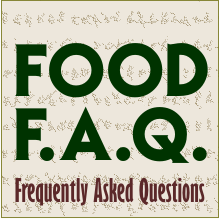 [dropcap1]Q. [/dropcap1] Can you tell me the difference in quantity between fresh and dried herbs? I usually have fresh herbs growing indoors or out, but sometimes I may have to substitute. What's the story?
[dropcap1]A. [/dropcap1]Fresh herbs are so much better than dried that it sometimes seems impossible that the dried and fresh versions of a given herb could possibly have come from the same plant. This is particularly true of basil, cilantro, parsley, chervil, and chives. Some herbs fare better: oregano, tarragon and thyme are at least recognizable in their dried form. A few don't register much of a difference at all: rosemary and other desert plants don't seem to be much affected at all by drying.
The problem is that for some herbs the fresh variety is hard to find out of season. In Italy, most chefs completely avoid using basil in the cold months, so great a loss of aroma and flavor is there. Every year at this time, I get a number of calls from people who want to know what to do with their basil plants before the first freeze, which kills the plant.
Another hallmark of dried herbs is that, in most cases, the flavor is twice as strong as it is in the fresh specimen. This is counterintuitive, and makes for problems when the recipe calls for fresh and you have only dried, or vice-versa.
One more thing: although you might think that once the herb is dried, it holds onto its flavor. Not so. Most dried herbs lose their flavor, even in unopened jars, after about a year.
Happy cooking!
[dropcap1]Q. [/dropcap1] Can you tell me the difference in quantity between fresh and dried herbs? I usually have fresh herbs growing indoors or out, but sometimes I may have to substitute. What's the story?
[dropcap1]A. [/dropcap1]Fresh herbs are so much better than dried that it sometimes seems impossible that the dried and fresh versions of a given herb could possibly have come from the same plant. This is particularly true of basil, cilantro, parsley, chervil, and chives. Some herbs fare better: oregano, tarragon and thyme are at least recognizable in their dried form. A few don't register much of a difference at all: rosemary and other desert plants don't seem to be much affected at all by drying.
The problem is that for some herbs the fresh variety is hard to find out of season. In Italy, most chefs completely avoid using basil in the cold months, so great a loss of aroma and flavor is there. Every year at this time, I get a number of calls from people who want to know what to do with their basil plants before the first freeze, which kills the plant.
Another hallmark of dried herbs is that, in most cases, the flavor is twice as strong as it is in the fresh specimen. This is counterintuitive, and makes for problems when the recipe calls for fresh and you have only dried, or vice-versa.
One more thing: although you might think that once the herb is dried, it holds onto its flavor. Not so. Most dried herbs lose their flavor, even in unopened jars, after about a year.
Happy cooking!
Written by Tom Fitzmorris November 17, 2014 11:01 in